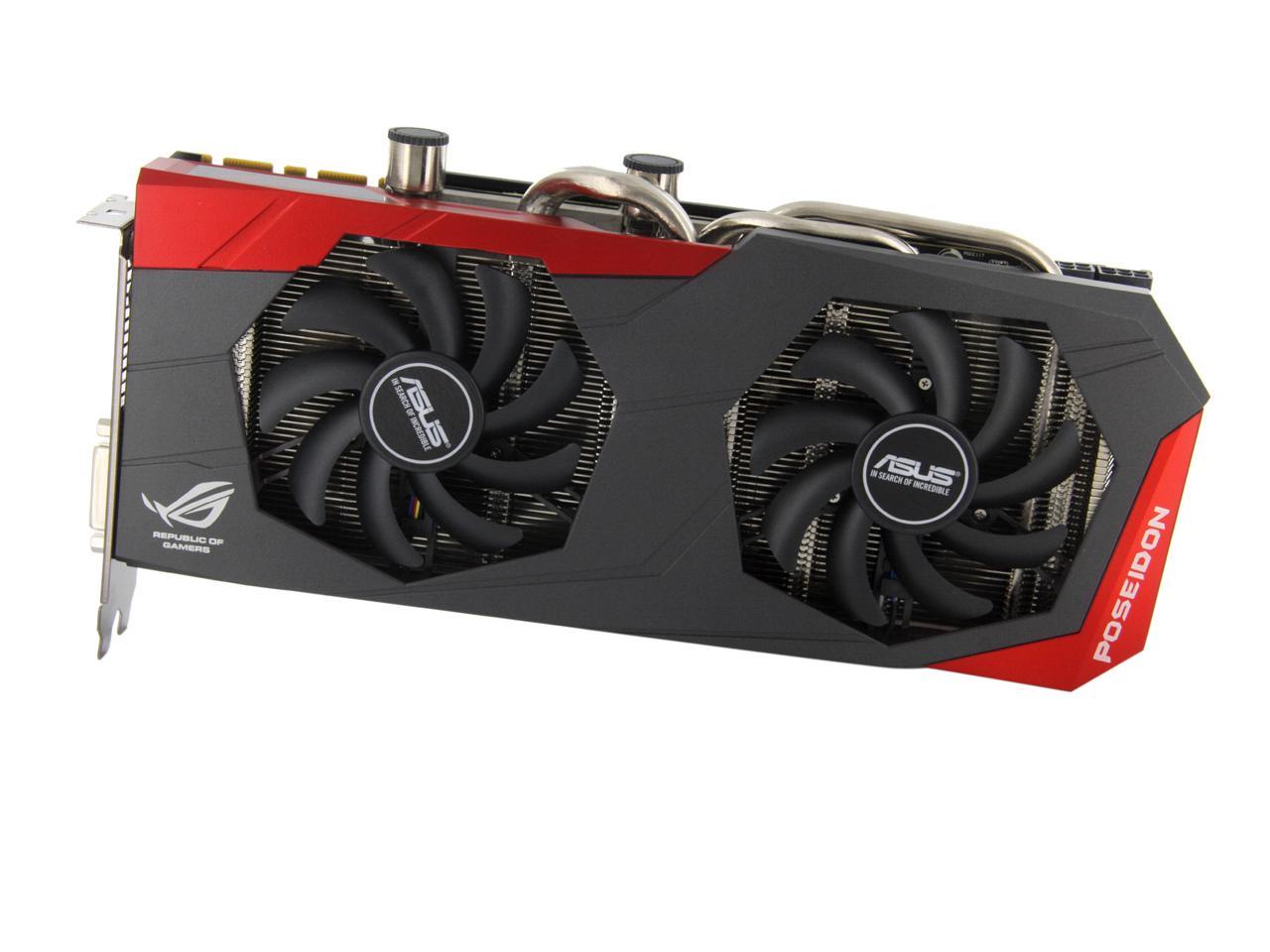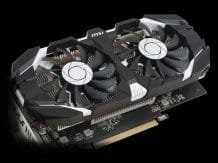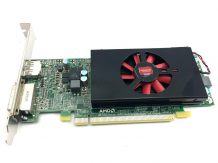ASUS ROG Matrix GTX 780 Ti Platinum Mining: Benchmark/ Spec/ Boost Clock (Speed): We continue to consider non-reference versions of top video cards made by ASUS. This time, let’s turn our attention to the most powerful GeForce GTX 780 Ti model, which is part of the premium overclocker product line. The highest factory overclock among all variations of the ASUS GeForce GTX 780 Ti, the best cooling and the best potential for overclocking – all this is about the ASUS ROG Matrix GTX 780 Ti Platinum.
ASUS ROG Matrix GTX 780 Ti Platinum (MATRIX-GTX780TI-P-3GD5)
This video card comes in a large box. The package design is designed in the corporate style, everything is decorated in red tones.
The side panel is folding. The spread describes the main features of ASUS Matrix Platinum. Through the transparent window you can see a solid cooling system.
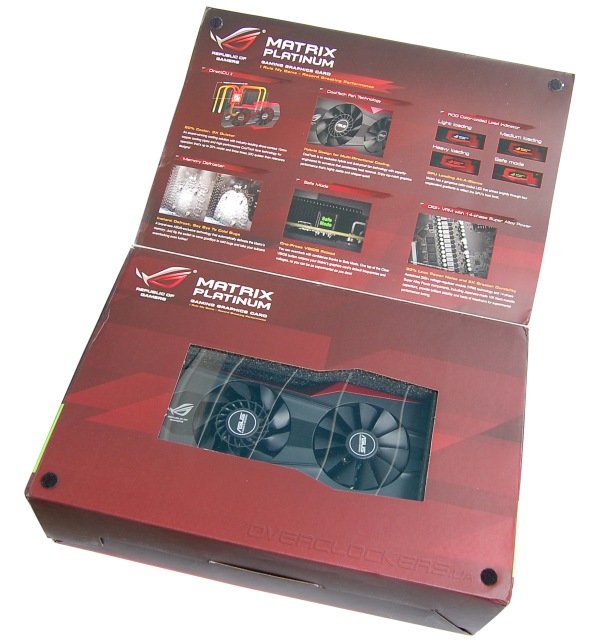
The scope of delivery is as follows:
- two PCI-E 6pin/8pin power adapters;
- ASUS ROG logo sticker;
- disk with software;
- instruction.
The video card is in a two-slot format, which is a bit unusual for Matrix. For example, even a weaker and cheaper Matrix-R9280X-P-3GD5 card was produced with a three-slot cooler. In this case, a new version of DirectCU II cooling with two fans of different designs is installed.
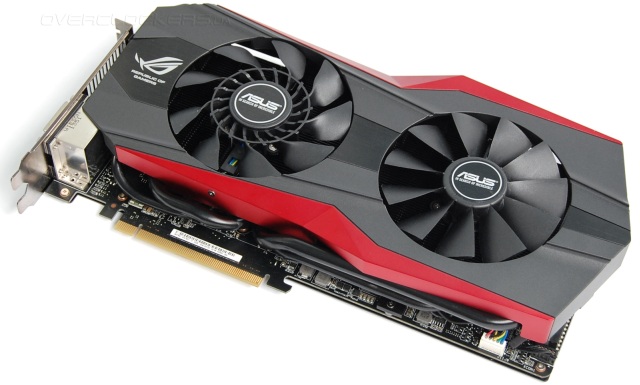
A casing of an unusual shape. Everything is done in black, even the heat pipes. Only the side faces of the casing are red. The design is catchy and even aggressive. At the same time, a certain continuity is maintained in appearance with the old products of the Republic of Gamers family.
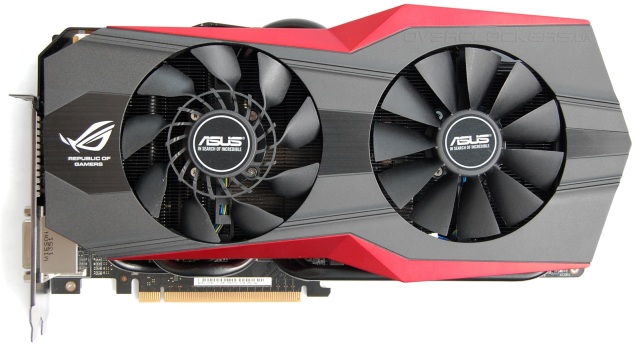
The reverse side is completely covered with a perforated metal plate.
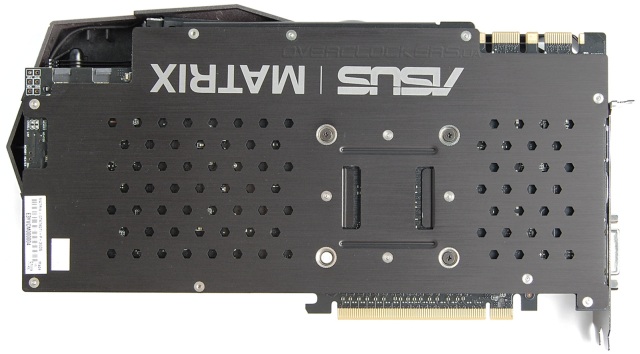
In the corner there is a zone with contacts for connecting VGA HotWire. When switching with ASUS ROG motherboards, voltage control from under UEFI is possible. There are several contact pads, the closure of which allows you to use a special LN2 mode with optimizations for extreme overclocking and some kind of special “memory heater” to avoid cold bugs at ultra-low temperatures. Two familiar eight-pin power connectors are complemented by a third Molex connector, which is very unusual for a video card. At the same time, ASUS works fine without connecting this connector. It is in demand, again, with extreme overclocking and ultra-high frequencies. You can also see the Safe Mode button on the edge of the board. It allows you to instantly reset all settings to the factory level.
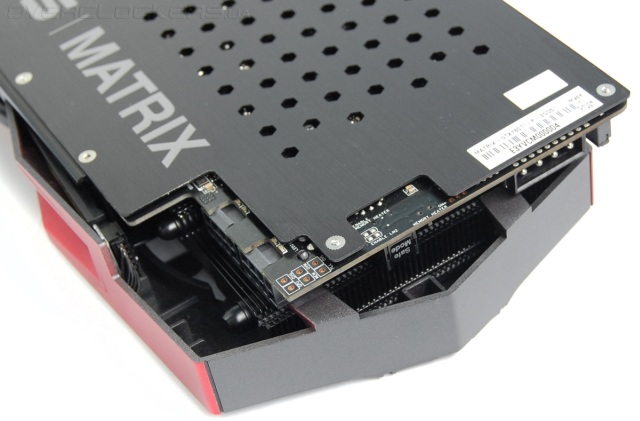
It is also worth noting the video card loading indicator in the form of a luminous inscription in the side window. The color changes from blue to red depending on the load level.
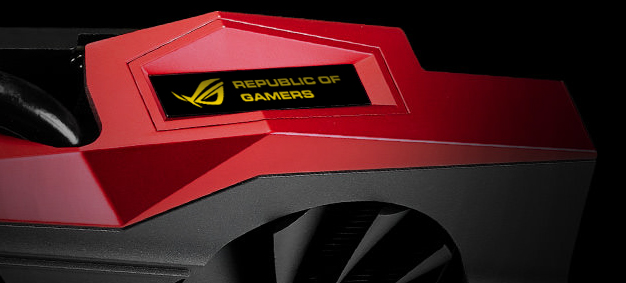
On the rear panel there are four connectors for connecting monitors: DisplayPort, HDMI and two DVI
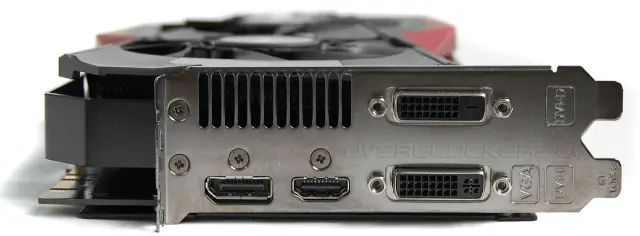
All elements of the cooling system are black, with the exception of the open pad of the base. The practicality of such a coating is questionable, but it looks very solid.
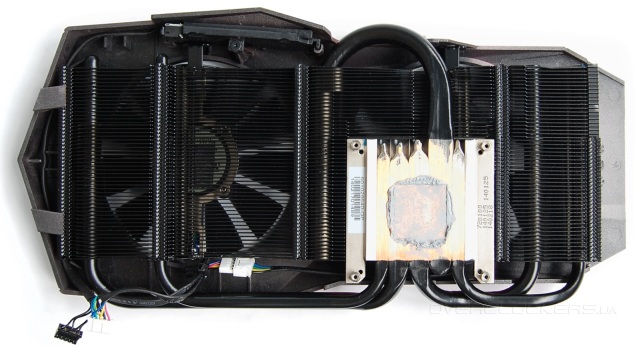
Except for the “man in black” style, the cooling is exactly the same as that of the ASUS GTX780TI-DC2OC-3GD5 and other representatives of the top segment from this manufacturer. It uses five heat pipes with direct contact technology. Three central ones are in direct contact with the surface of the crystal – one 10 mm in diameter and two 8 mm each. Side tubes of the usual diameter of 6 mm.
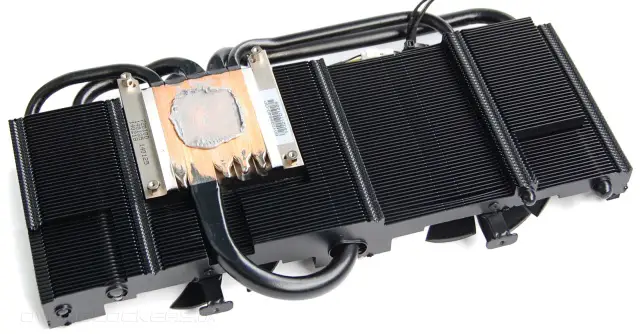
In this model, the casing is attached to the radiator with only two screws. On the other hand, it clings to the ribs with snaps. To avoid vibration in this place, the radiator has a soft gasket. The fastening strips on which the fans are mounted are thin so as not to create air resistance. The compartments in the radiator for fans are not of the usual square shape, but with various protruding fragments. Thus, the engineers tried to fully utilize the entire available volume to increase the scattering area.
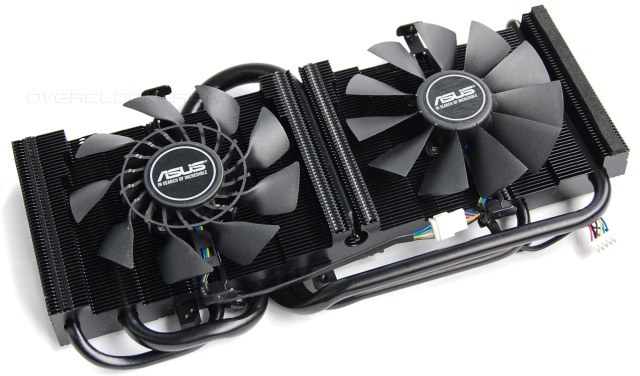
The most interesting fan is located on the left side of the video card. It combines the design features of conventional axial models and centrifugal fans. The impeller includes an inner ring with “blades” and conventional blades on the outside. This increases the airflow area, allowing air to pass through the sides of the radiator as well. Thanks to this design, part of the air is also blown out of the case. The second fan has a classic design, but with a large number of blades, which has a very beneficial effect on its efficiency.
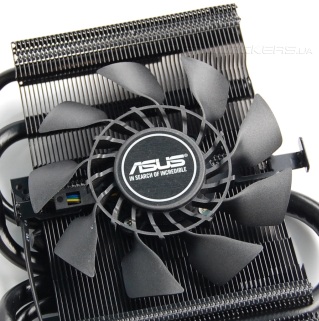
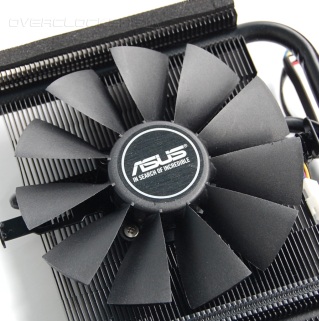
The wires stretching from the fans are fixed with ties.
The power components on the board have their own heatsink. Not very large, I must admit, but perfectly blown.
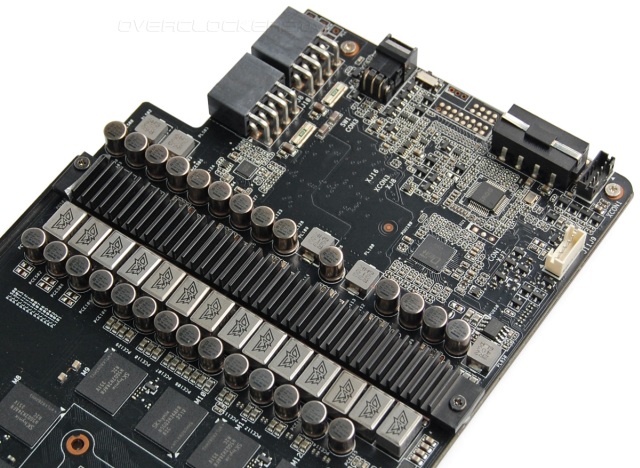
The plate on the reverse side does not come into contact with any elements, although it partially helps to normalize the thermal load. Together with a stiffening rib, this plate prevents the textolite from deforming under the weight of massive cooling.
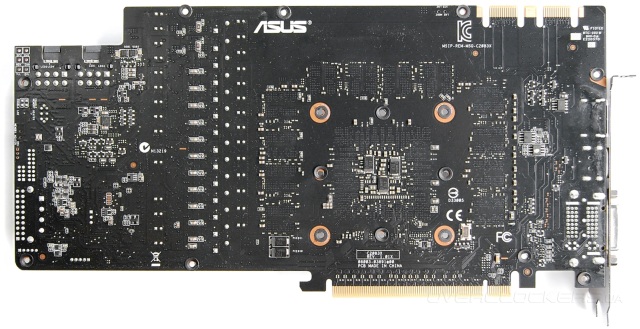
The printed circuit board is larger compared to the GTX780TI-DC2OC-3GD5 due to the larger number of phases. High quality branded components are used in accordance with the Super Alloy Power standard.
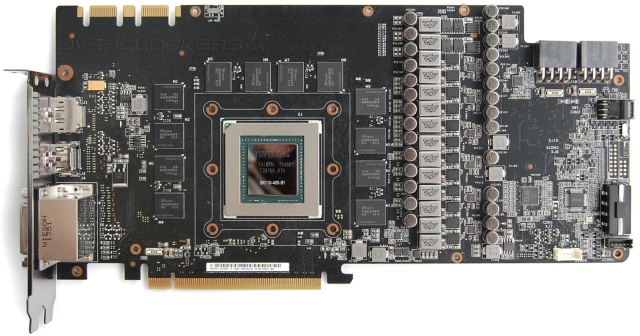
The power node has 14 phases! 12 of them are in the GPU voltage converter. The PWM controller is a Digi + VRM ASP1212 chip.
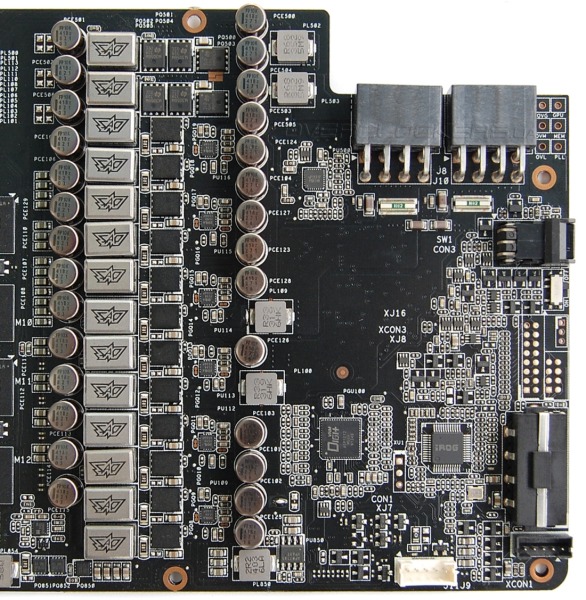
GPU GK110-425-B1 in person:
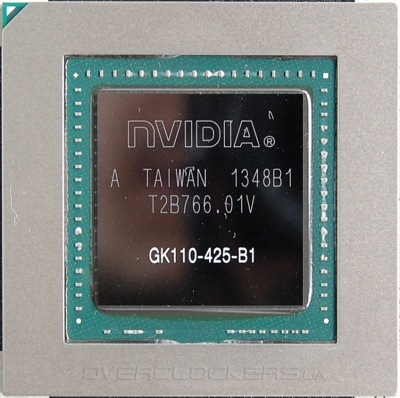
Three gigabytes of memory are filled with 12 SKhynix H5GQ2H24AFR R2C chips.
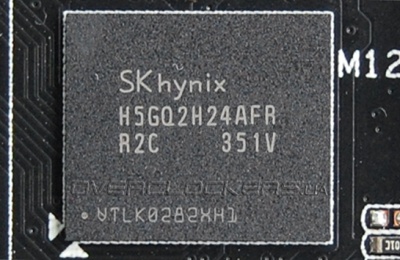
As an additional illustration, here is a slide that clearly displays the elements of the overall design of the Matrix GTX 780 Ti Platinum with a description of some design and technical features.
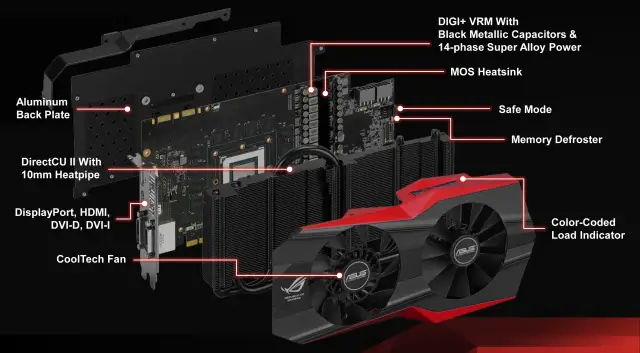
Now let’s talk about operating frequencies. Naturally, it was not without factory overclocking. The base frequency of the Matrix is increased to 1006 MHz instead of the recommended value of 875 MHz. Official Boost Clock 1072 MHz. But the memory operates at the prescribed frequency of 7000 MHz.
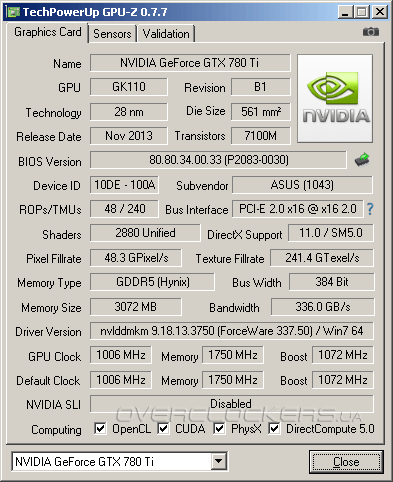
The GPU-Z utility determined ASIC Quality at 72%.
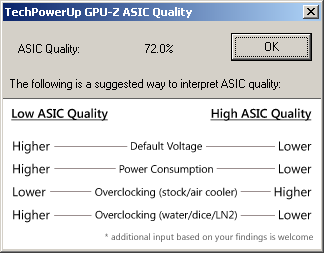
Under load, the actual Boost frequency was kept at 1137-1150 MHz. That is, the advantage over the reference is even more impressive than when comparing by base frequencies. After a 13-minute warm-up with the Unigine Valley benchmark, the peak temperature did not exceed 76°C. This is below the temperature of ASUS GTX780TI-DC2OC-3GD5. The most surprising thing is that the Matrix was also quieter, as the fan speed barely reached 1570 rpm.
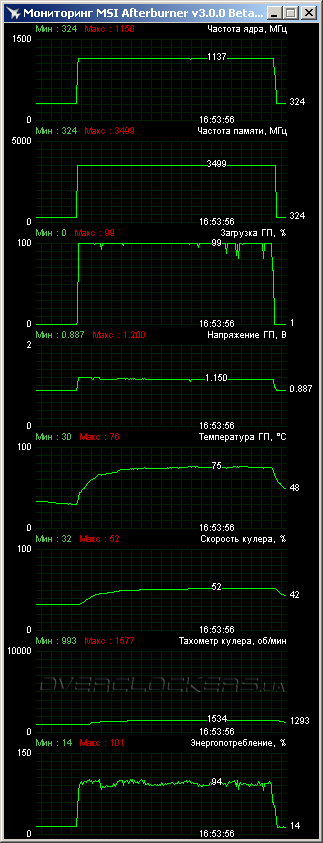
It’s rare that the faster version is quieter and cooler than the lower frequency model. Moreover, there are no design differences in the cooling systems. Looking ahead, I note that Matrix showed lower performance in terms of power consumption, and therefore the GPU is colder. Perhaps Matrix is more successfully balanced in terms of initial operating voltages. It is possible that our copy of the ASUS GTX780TI-DC2OC-3GD5 was also unsuccessful.
But in overclocking Matrix proved to be in solidarity with ASUS DC2OC, demonstrating the same frequency indicators, which do not differ from overclocked reference cards. According to the base frequency, overclocking was 1057 MHz with a peak value of 1200 MHz. Memory above 7776 MHz did not work. The voltage is increased by 16 mV.
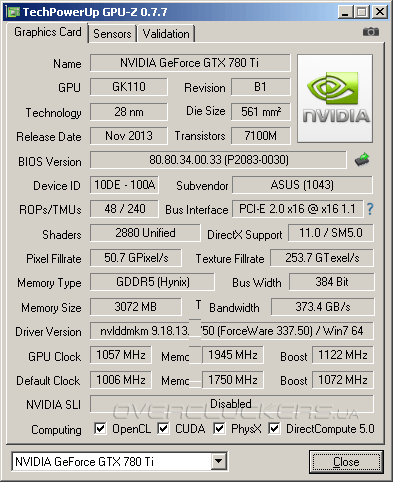
The result is not impressive. But this is not the limit of the map. Just a further increase in the core frequency led to the appearance of artifacts, which nullified the practicality of such overclocking. On the other hand, the card easily kept the final frequencies of 1057-1200/7776 MHz at fan speeds of less than 2000 rpm. That is, such overclocking is quite suitable for everyday use.
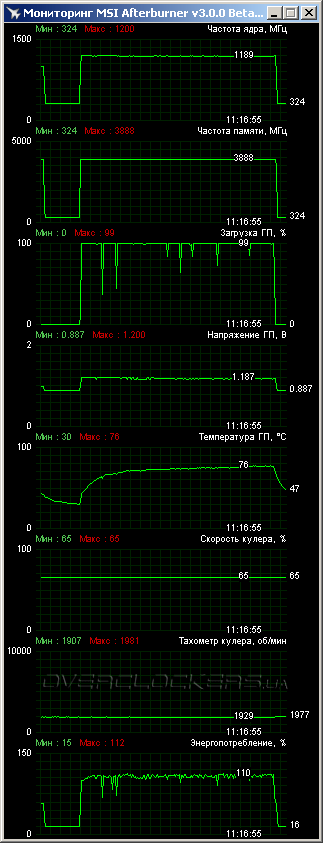
For the reference and ASUS GTX780TI-DC2OC-3GD5, similar frequencies required putting the cooling system into a very noisy mode. Characteristics of the tested video cards
The considered video adapter is comparable with the ASUS GTX780TI-DC2OC-3GD5, the reference GeForce GTX 780 Ti and GeForce GTX 780. Since all our GeForce GTX 780 Ti have the closest overclocking frequencies, only Matrix was tested in this mode, the rest of the comrades are nominal. The younger GeForce GTX 780 has been tested in both modes. AMD’s competitors include non-reference versions of the Radeon R9 290X from MSI and ASUS. The latter also acts as a standard version of the Radeon R9 290X. Also added Radeon R9 290 (ASUS R9290-DC2OC-4GD5).
I note that for the older GeForce video driver 337.50 was used, and the GeForce GTX 780 was tested on the older 335.23. The new video driver promises a noticeable speedup in a number of applications, but in our list of games it showed up only in isolated cases. So this combination of different software is critical.
The table for GeForce shows the official data on the average Boost Clock. The graphs show the full range of frequencies of the core, including hardly reached peak values.
ASUS ROG Matrix GTX 780 Ti Platinum: Specs
| Video adapter | MSI R9 290X Lighting | ASUS R9290X-DC2OC-4GD5 | Radeon R9 290X | Radeon R9 290 | ASUS ROG Matrix GTX 780 Ti Platinum | ASUS GTX780TI-DC2OC-3GD5 | GeForce GTX 780 Ti | GeForce GTX 780 |
| Core | Hawaii | Hawaii | Hawaii | Hawaii | GK110 | GK110 | GK110 | GK110 |
| Number of transistors, million pieces | 6020 | 6020 | 6020 | 6020 | 7100 | 7100 | 7100 | 7100 |
| Process technology, nm | 28 | 28 | 28 | 28 | 28 | 28 | 28 | 28 |
| Core area, sq. mm | 438 | 438 | 438 | 438 | 561 | 561 | 561 | 561 |
| Number of stream processors | 2816 | 2816 | 2816 | 2560 | 2880 | 2880 | 2880 | 2304 |
| Number of texture blocks | 176 | 176 | 176 | 160 | 240 | 240 | 240 | 192 |
| Number of render units | 64 | 64 | 64 | 64 | 48 | 48 | 48 | 48 |
| Core frequency, MHz | to 1080 | to 1050 | up to 1000 | to 947 | 1006–1072 | 954–1020 | 875–926 | 863–900 |
| Memory bus, bit | 512 | 512 | 512 | 512 | 384 | 384 | 384 | 384 |
| Memory type | GDDR5 | GDDR5 | GDDR5 | GDDR5 | GDDR5 | GDDR5 | GDDR5 | GDDR5 |
| Memory frequency, MHz | 5000 | 5400 | 5000 | 5000 | 7000 | 7000 | 7000 | 6008 |
| Memory size, MB | 4096 | 4096 | 4096 | 4096 | 3072 | 3072 | 3072 | 3072 |
| Supported version of DirectX | 11.2 | 11.2 | 11.2 | 11.2 | 11.1 | 11.1 | 11.1 | 11.1 |
| Interface | PCI-E 3.0 | PCI-E 3.0 | PCI-E 3.0 | PCI-E 3.0 | PCI-E 3.0 | PCI-E 3.0 | PCI-E 3.0 | PCI-E 3.0 |
| Power, W | n / a | n / a | 290 | 275 | n / a | n / a | 250 | 250 |
Test Benchmark: ASUS ROG Matrix GTX 780 Ti Platinum
The test bench configuration is as follows:
- processor: Intel Core i7-3930K ([email protected] GHz, 12 MB);
- кулер: Thermalright Venomous X;
- motherboard: ASUS Rampage IV Formula/Battlefield 3 (Intel X79 Express);
- memory: Kingston KHX2133C11D3K4/16GX (4x4GB, DDR3-2133@1866MHz, 10-11-10-28-1T);
- system disk: Intel SSD 520 Series 240GB (240 GB, SATA 6Gb/s);
- secondary drive: Hitachi HDS721010CLA332 (1 TB, SATA 3Gb/s, 7200 rpm);
- power supply: Seasonic SS-750KM (750 W);
- monitor: ASUS PB278Q (2560×1440, 27 ″);
- operating system: Windows 7 Ultimate SP1 x64;
- GeForce GTX 780 Ti driver: NVIDIA GeForce 337.50;
- GeForce GTX 780 driver: NVIDIA GeForce 335.23;
- Radeon R9 280X driver: ATI Catalyst 14.3.
User Account Control, Superfetch and interface visual effects were disabled in the operating system. Driver settings are standard. The testing methodology is described here.
Test results
Assassin’s Creed IV: Black Flag

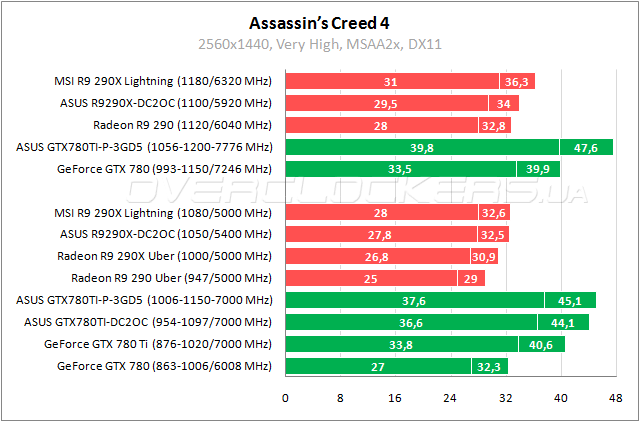
In Assassin’s Creed, the review hero is 11% faster than the reference hero. The advantage over the fastest version of the Radeon R9 290X reaches 34-38%. Gain from overclocking 6%.
Battlefield 4

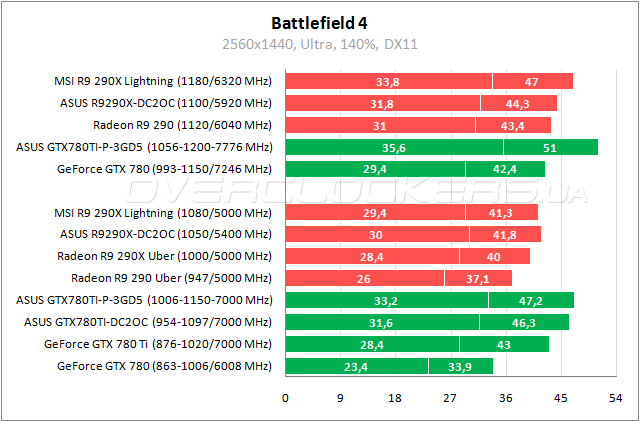
The gain compared to the regular GeForce GTX 780 Ti in Battlefield 4 is at the level of 10-17%. The fastest representative of AMD is 11-13% weaker. The increase from overclocking in Matrix is up to 8%.
Call of Duty: Ghosts

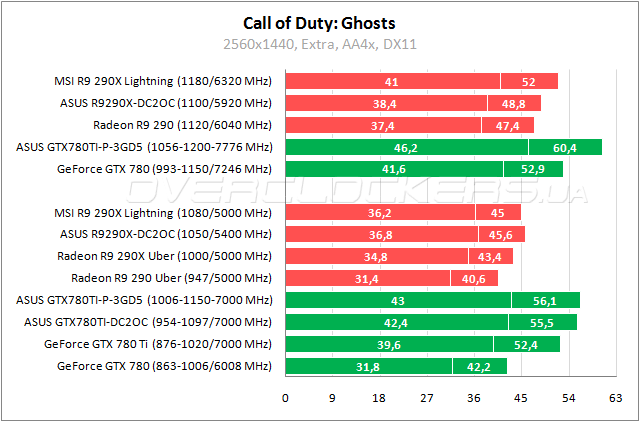
No more than 9% advantage over the reference of Matrix in Ghosts. 17-23% weaker than the fastest Radeon.
Crysis 3
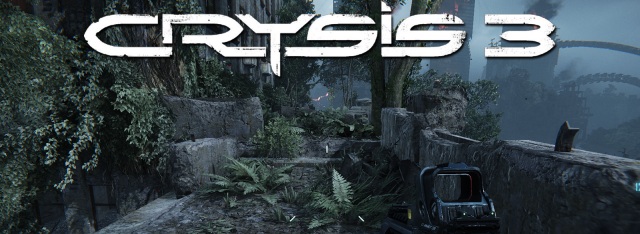
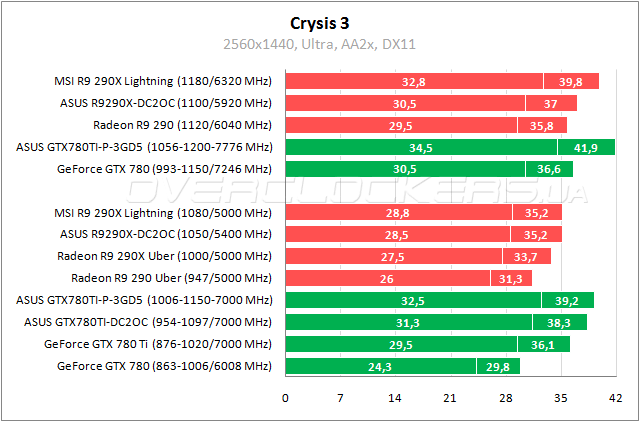
In Crysis 3, ASUS Matrix again confidently leads. MSI R9 290X Lighting is 11-13% weaker. Gain from overclocking 7%.
Hitman: Absolution

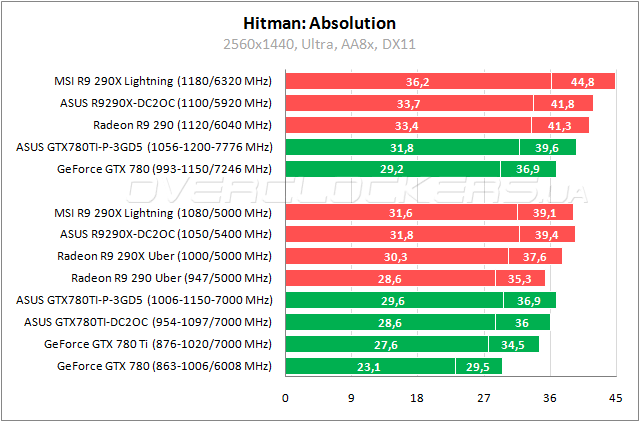
In the latest Hitman, AMD’s solutions take the lead. Here, even the Matrix falls short of the level of a simple Radeon R9 290X in Uber mode. Increasing the frequencies allows you to slightly overtake the Lighting operating at its nominal value.
Metro: Last Light

First, let’s look at the results of manual testing on the “Ashes” level in Metro: Last Light.
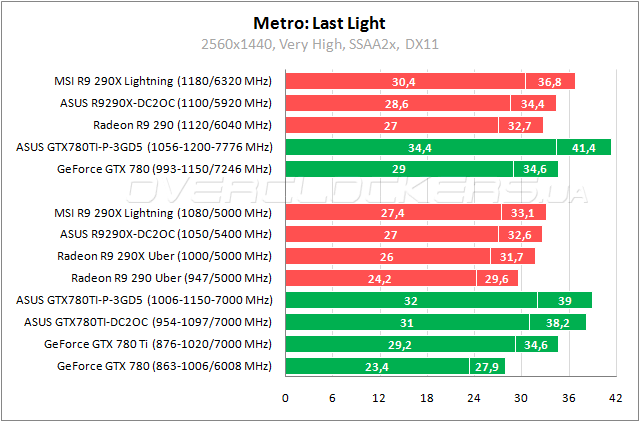
ASUS Matrix is ahead by a wide margin. It is 10-13% more productive than a regular reference brother. Lagging Lighting at the level of 17-18%.
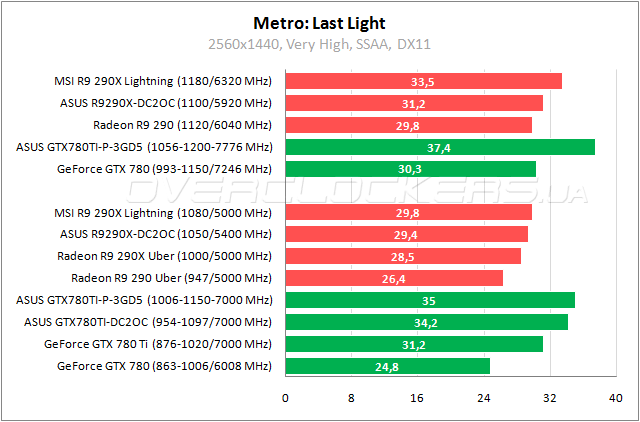
The alignment of forces in the built-in benchmark is similar.
Thief

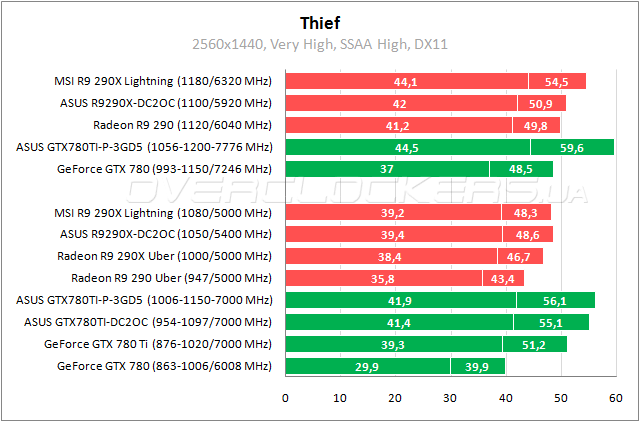
In Thief, the advantage of Matrix over the reference is 7-10%. The difference with the simpler ASUS is minimal. Overclocking gives an additional acceleration of 6%. The game supports the new ATI Mantle, but, as one of the old tests //www.overclockers.ua/video/amd-radeon-r9-290-asus-dc2oc/3/ showed, with our powerful test processor, the top Radeons do not receive from this no growth.
Tom Clancy’s Splinter Cell: Blacklist

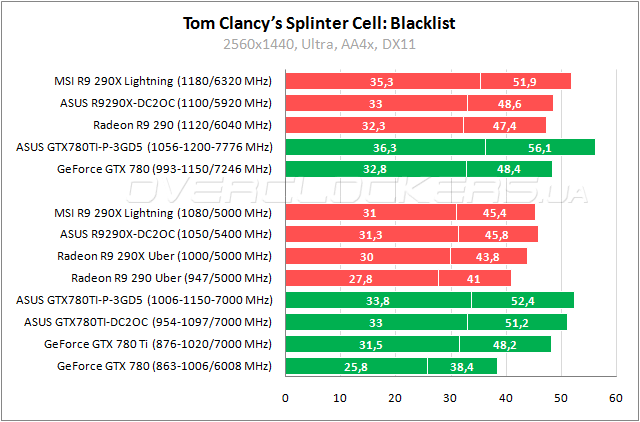
Matrix shows a 7-9% gain on the Blacklist over the reference GeForce GTX 780 Ti. ASUS R9290X-DC2OC is the leader among AMD, but it is also weaker than the hero of the review by 8-14%. Matrix gains 7% from overclocking.
Tomb Raider

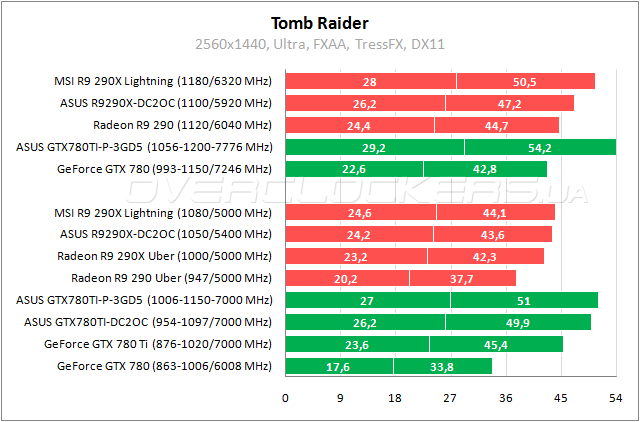
In Tomb Raider, the difference between ASUS and the regular version of the GeForce GTX 780 Ti is 12-14%. A simple Radeon R9 290X is 16-20% weaker. Faster Lighting loses 10-16%.
Total War: Rome 2

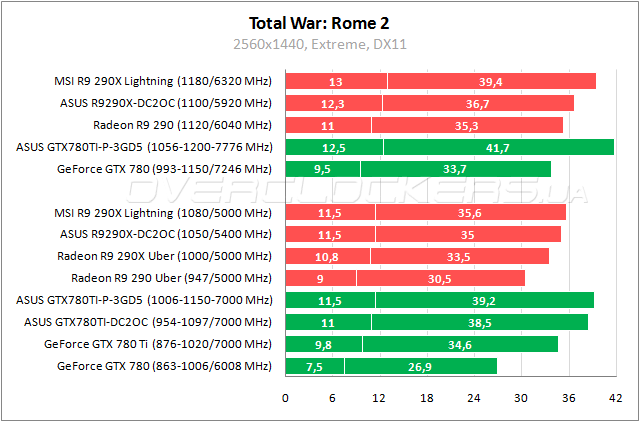
Once again, ASUS Matrix leads in terms of rating and overclocking, outperforming all Radeon R9 290X models.
Unigine Valley benchmark

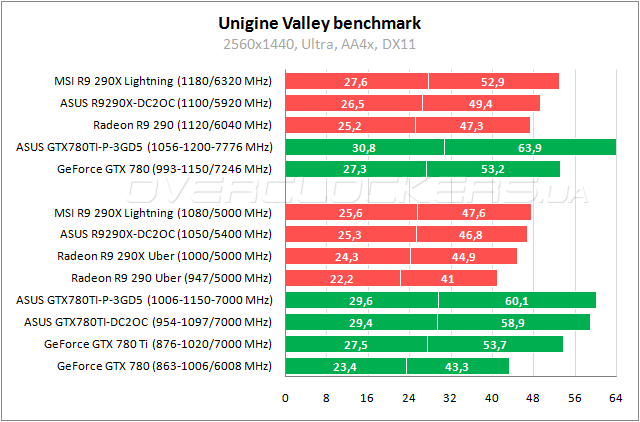
In this test, the hero of the review demonstrates a huge lead over AMD solutions. The most powerful version of the Radeon R9 290X is 16-26% weaker.
3DMark 11

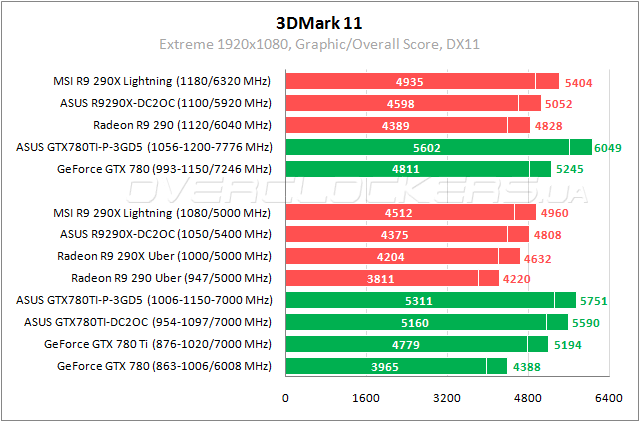
The difference between ASUS Matrix and the reference is 11%. 18% weaker than MSI Lighting. The increase from overclocking is 5.5%.
3DMark Fire Strike

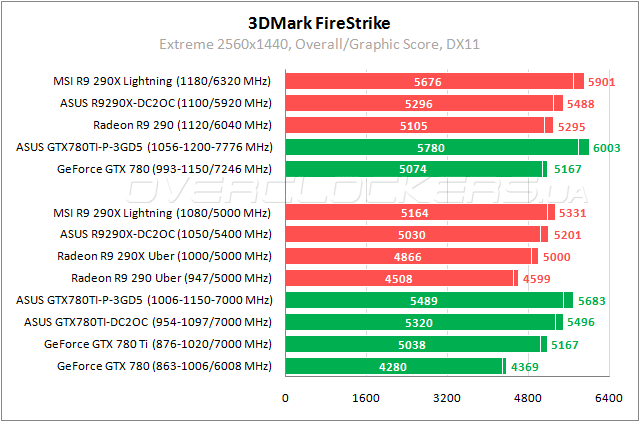
Slightly loses positions Matrix, outperforming Lighting only 6%. The difference with a simple Radeon R9 290X is 13%.
Energy consumption
The overclocked results of all NVIDIA representatives have been added to this comparison.
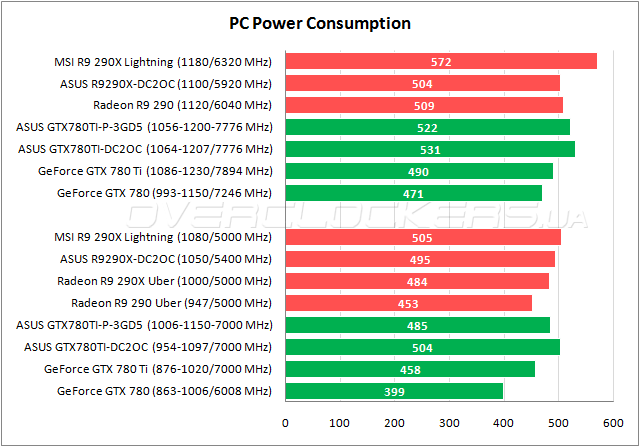
Matrix is more economical than its fellow ASUS and older versions of the Radeon R9 290X.
conclusions
The ASUS ROG Matrix GTX 780 Ti Platinum graphics card will please the user with a very high factory overclocking combined with low noise and low operating temperatures. This is already a winning combination. However, we always expect record-breaking overclocking from Matrix. In this case, all the power of a multi-phase power system with additional overclocking features does not give any dividends when overclocked in the air. When using conventional software tools, the final overclocking is average. But it is implemented with moderate noise, which is beyond the power of the reference. So the average user will get very tangible advantages over ordinary cards on Matrix. But at its high price, this is not the most outstanding option in the GeForce GTX 780 Ti series. Although very high quality and solid.




